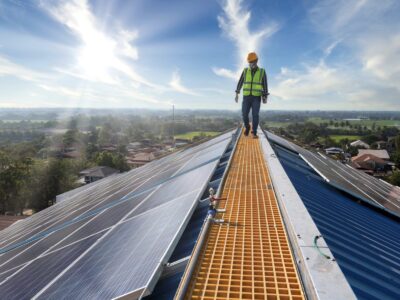It has become clear to most of us that addressing climate change will require everyone to make changes. Whether it’s private industry, daily government operations, or even your own decision to recycle or not, a collective buy-in from the entire world is the only sure way to make the adjustments necessary for a clean, mutually equitable future.
At the same time, there is validity to looking inward for better ways to make the necessary changes. Though it is crucial to hold institutions accountable, focusing on sustainability within one’s community is a great idea for ensuring that actionable change through individual effort occurs.
Much of this philosophy appears in the core values of organizations like Indigenized Energy Initiative (formerly Covenant Tribal Solar Initiative). It is a nonprofit that aims to help the progress of solar and renewable development among Indigenous groups all around the U.S. To the bright minds behind the company, Indigenous communities, in particular, represent how the power of collective enthusiasm within insular groups can form world-shifting movements.
In many ways, Indigenous groups present a great deal of untapped potential for solar and wind energy development, especially with the decline of a fossil fuels industry that has long been a source of economic prosperity. “This is economic development with really high human impact,” proclaimed Cheri Smith, Indigenized Energy Initiative founder. “We are disrupting the broken fossil fuel-based energy system.”
Several factors immediately jump out when considering the possibility of courting renewable development on Indigenous lands. To build an infrastructure for solar energy generation, you need a place to put it.
According to the National Renewable Energy Laboratory, land owned by Tribes in the lower 48 states has the potential to generate a whopping 17.6 billion kilowatt-hours of solar energy every year.
Comparatively, the entire U.S. generated about 4 billion kilowatt-hours of energy in 2020, with less than 3% coming from solar power.
There is also a willingness in these communities to make the transition to solar. The economic factor is a big part of this — with fossil fuels on the decline, many of the working-age members of these Tribes have begun to seek out alternative industries as a source of en masse employment. Renewable energy could be the logical stepping stone, allowing industry workers a cleaner conscience than working in oil and gas. Indigenous groups have traditionally been very sustainable and have long been renowned for their culturally-ingrained farming techniques that prioritize soil and crop health.
The economics behind solar development has been an important motivating factor for Indigenized Energy Initiative’s continued success in working with Tribal communities. “Our long-term goal is a return to self-determination and restoration of hope,” says Smith, who created the Indigenized Energy Initiative primarily to assist the communities themselves with understanding how to develop and operate these solar projects. This way, the Tribes build the installations on their terms instead of relying on outside funding with no requisite training. “Oftentimes what happens is when systems are donated, they’re dumped there, and then the donor goes away, and the Tribe is left with a hulking mess,” Smith says.
Although the country is probably more than a few years away from filling out that 17 billion kilowatt-hours of solar potential, Indigenized Energy Initiative has remained active in getting projects off the ground. There are six installations in progress at the Northern Cheyenne reservation in Montana, with 12 trained solar panel installation professionals. All are ready to spread their knowledge across many Tribal communities throughout the Great Plains. Indigenized Energy Initiative is on its way to fulfilling its mission.





